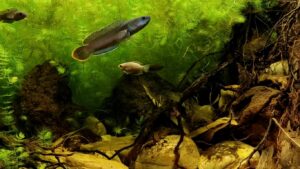Subansiri river,small pond near the main chanel
_st place in Biotope Aquarium Design Contest 2022

Volume of aquarium: 300 liters
Dimensions of aquarium: 120x50x50
List of fishes: Channa Gachua
Trichogaster Chuna
List of plants: Ceratophyllum Demersum
Description of Decorations and Substrate: Aquarium decoration is large and small stones, the substrate consists of fine sand granulation 0.3-0.8 and pebbles, wood and branches as you would find in nature
Description of Equipment: HMF filter with return pump 900 l/h
Led light 25w 7500K
Water Parameters: The temperature depends on the time of year because the aquarium has no heater and fluctuates between 18 ° C in winter and 26 ° C in summer, the pH is 7.5 kh 8
Additional Info: I change the water once every 14 days
Aquarium video:
Description of the Area Surrounding the Biotope: The Subansiri River is a tributary of the Brahmaputra River in the Indian states of Assam and Arunachal Pradesh, and the Tibet Autonomous Region of China. The Subansiri is 442 kilometres (275 mi) long, with a drainage basin 32,640 square kilometres (12,600 sq mi) large. The Subansiri is the largest tributary of the Brahmaputra. Its maximum observed discharge was 18,799 cubic metres per second (663,900 cu ft/s), and its minimum 131 m3/s (4,600 cu ft/s). It contributes 7.92% of the Brahmaputra’s total flow.
The Subansiri River originates in the Himalayas, in Tibet.It flows east and southeast into India, then south to the Assam Valley, where it joins the Brahmaputra River in Lakhimpur district.
Subansiri lends its name to two districts in Arunachal Pradesh: Upper Subansiri and Lower Subansiri.
River
The river is also the home to a mythical fish from the family Cyprinidae golden masheer (Tor Putitora).
The name is derived from a Sanskrit word ‘swarn’ meaning gold, Subansiri is called the River of gold. In early days, gold mining served as a major industry that was developed through ages in experimenting the traditional methodologies. The river bed sands were scanned and identified; gold particles are then extracted and processed
Description of the Underwater Landscape of the Biotope: The river bottom of the Subansiri River is mostly composed of stones of various sizes and fine sand, in the part of the rapid flow the river carries with it everything that falls into the river,this material in the form of stones, wood, branches, leaves is later deposited in quieter parts of the river where we find the habitat of the aquarium, the aquarium represents a small pond next to the main canal where the water is practically standing and there is a lot of aquatic vegetation,these fish would be very difficult to find in the main course of the river, they usually inhabit stagnant and slow-flowing waters such as streams, ditches, ponds,the aquarium does not have a heater because it is inhabited by subtropical species and temperature fluctuations are good for their health, aquarium has been in operation for over a year and although the strange combination of fish Channas despite being predators so far does not show any aggression against other species
Description of the Habitat Parameters: Temperature is 18°C-22°C
Ph 6-7.35
TDS 135
Water it is clear to muddy depending on several factors
List of Fishes and Invertebrates Occurring in the Nature Biotope: Danio rerio
Pethia conchonius
Hara jerdoni
Badis assamensis
Parambassis lala
List of Plants Found in the Nature Biotope: Ceratophyllum Demersum
Vallisneria spiralis
Pistia stratiotes
Threats to the Ecology of the Biotope: River is facing great problems from the ecological point of view of excessive siltation by hydroelectric power plants, dumping of garbage in the river, erosion and decline of fertile land due to excessive excavation of stones and sand from the river, increase of agricultural land along the river river, there is currently very little accurate research and no accurate data on the current state of the river,given that India is one of the hotspots of aquarium fish spiecies, increasing pollution does not represent a bright future for these species and, ultimately, for the people who live there.
Sources of Information:
https://www.academia.edu/15441684/A_Comparative_Analysis_of_Selected_Environmental_Parameters_of_Water_Quality_of_the_Subansiri_River_in_Eastern_Himalayas_and_the_Alaknanda_River_in_Western_Himalayas
https://drive.google.com/file/d/1GPs_99DJHAr6LZyJ0b_ki4-XqqsrysGa/view?usp=drivesdk
https://drive.google.com/file/d/1Ik1CPGTRTLx5edM9TRRdRD1WFj636VGs/view?usp=drivesdk
https://drive.google.com/file/d/1GS2iT6-jsEI-Ix_zp9F45KEPlTZ2RQWa/view?usp=drivesdk
https://drive.google.com/file/d/1AbqvofSxMTVl2wD-vxPwxhBB4vbPeawG/view?usp=drivesdk
https://drive.google.com/file/d/1GCgVVC0VxAigiyKqNcBJxmrwIZnFVUFI/view?usp=drivesdk
https://drive.google.com/file/d/1GG3Tizzm2Q0Ud4h_70sc2LOnvKIAMGw1/view?usp=drivesdk
